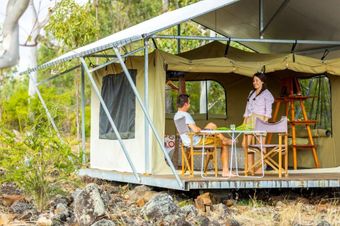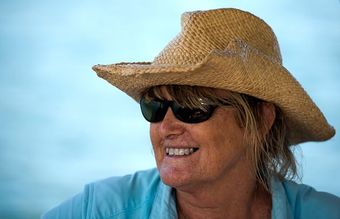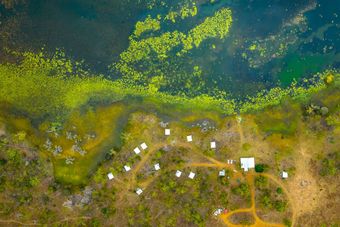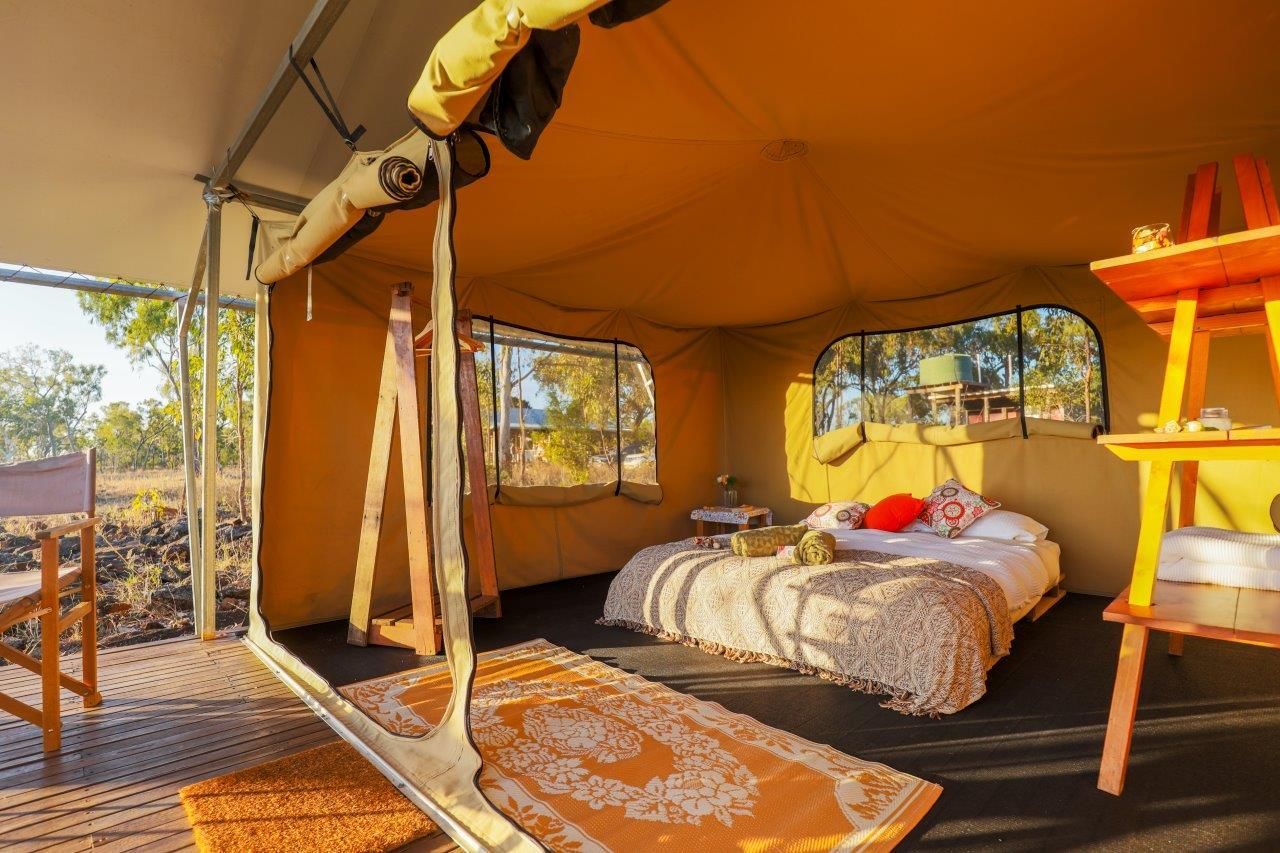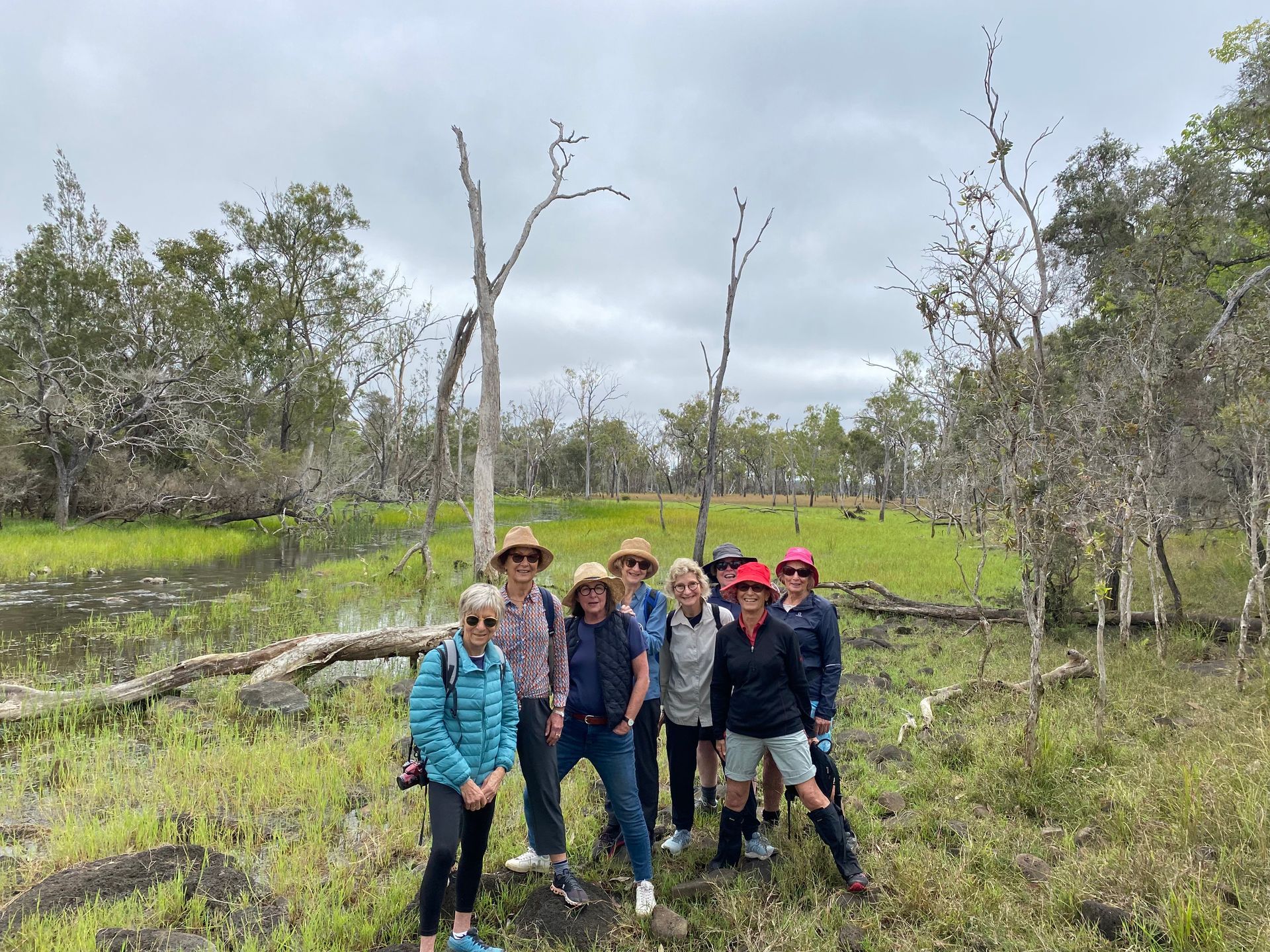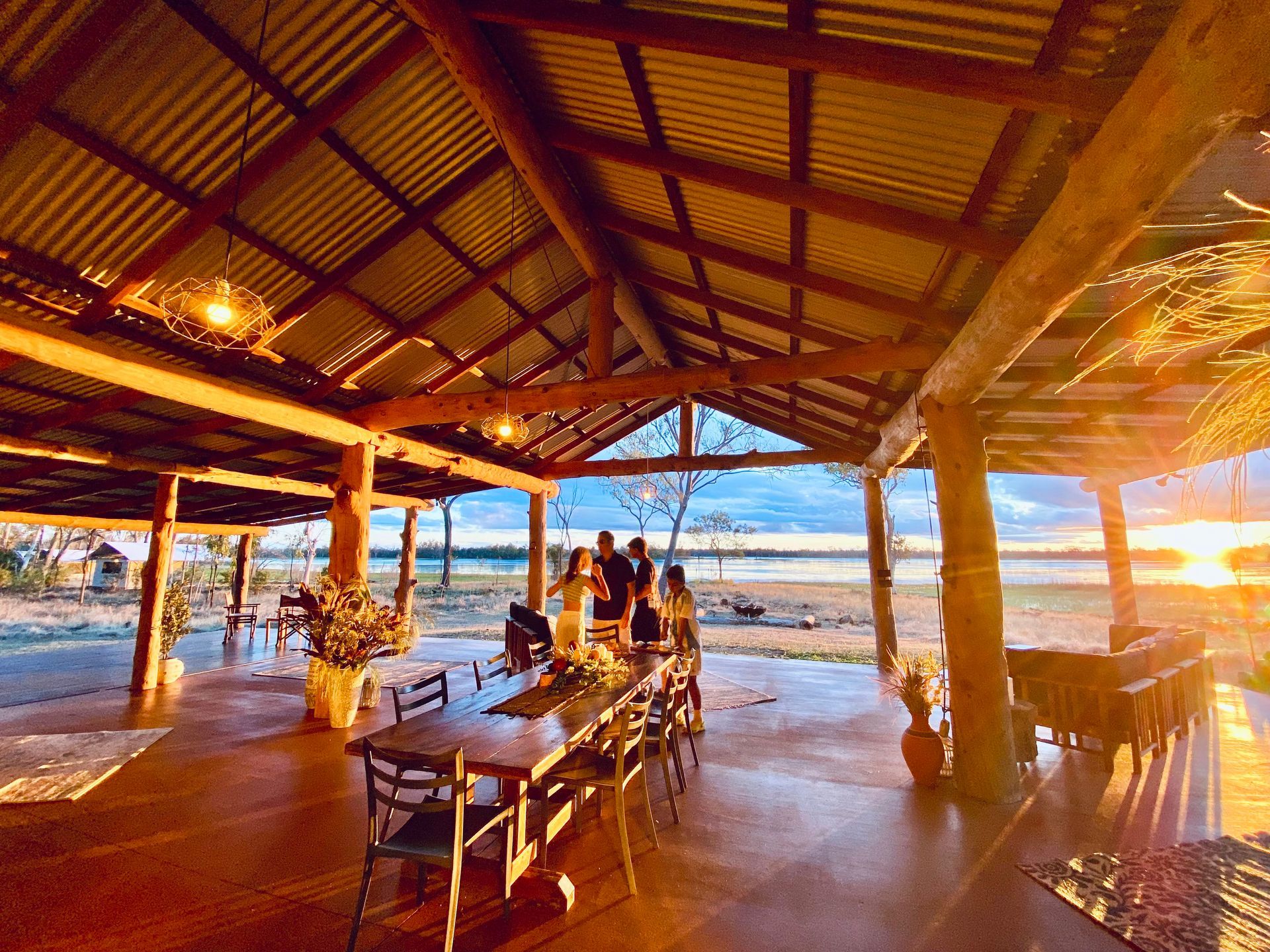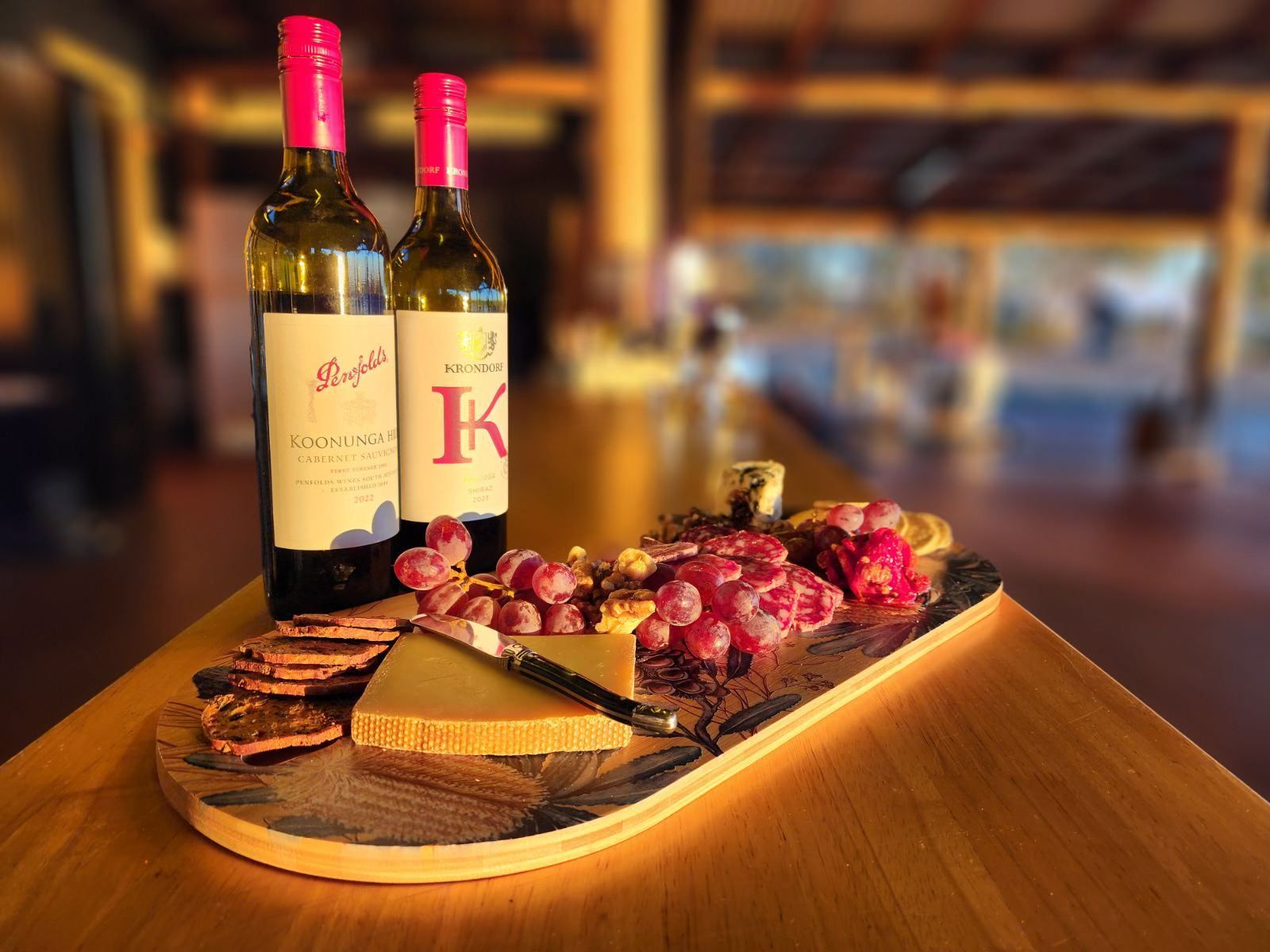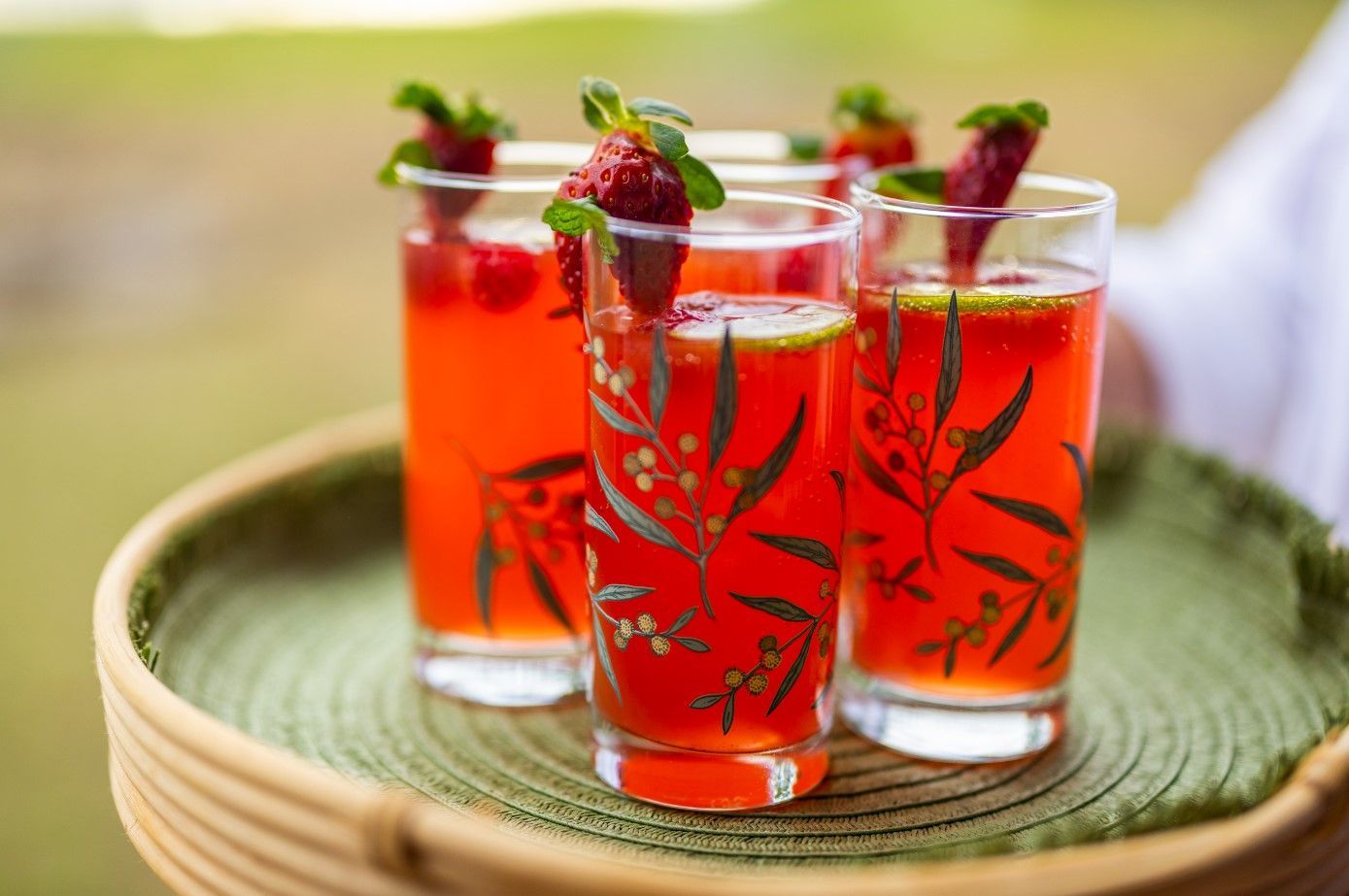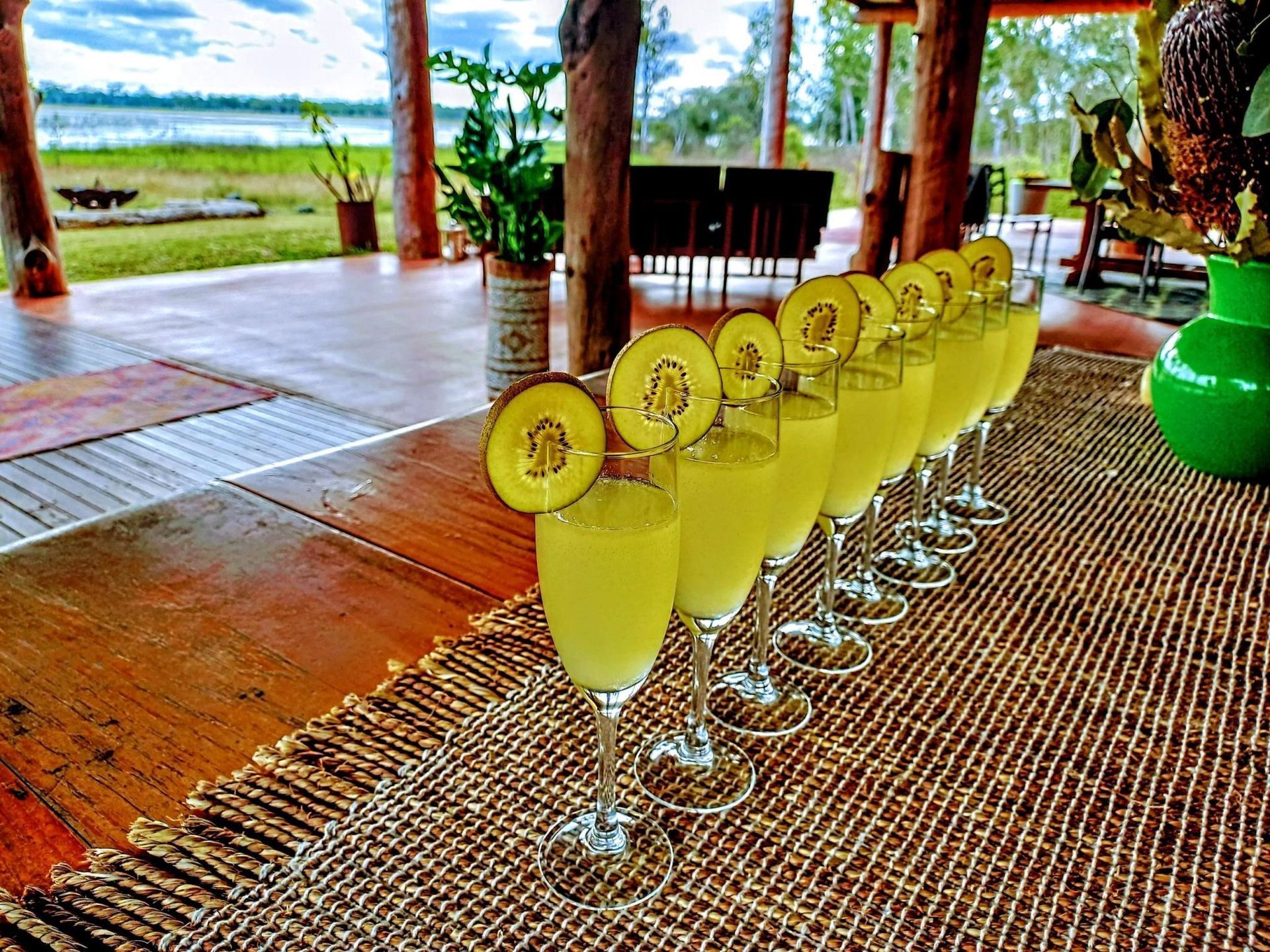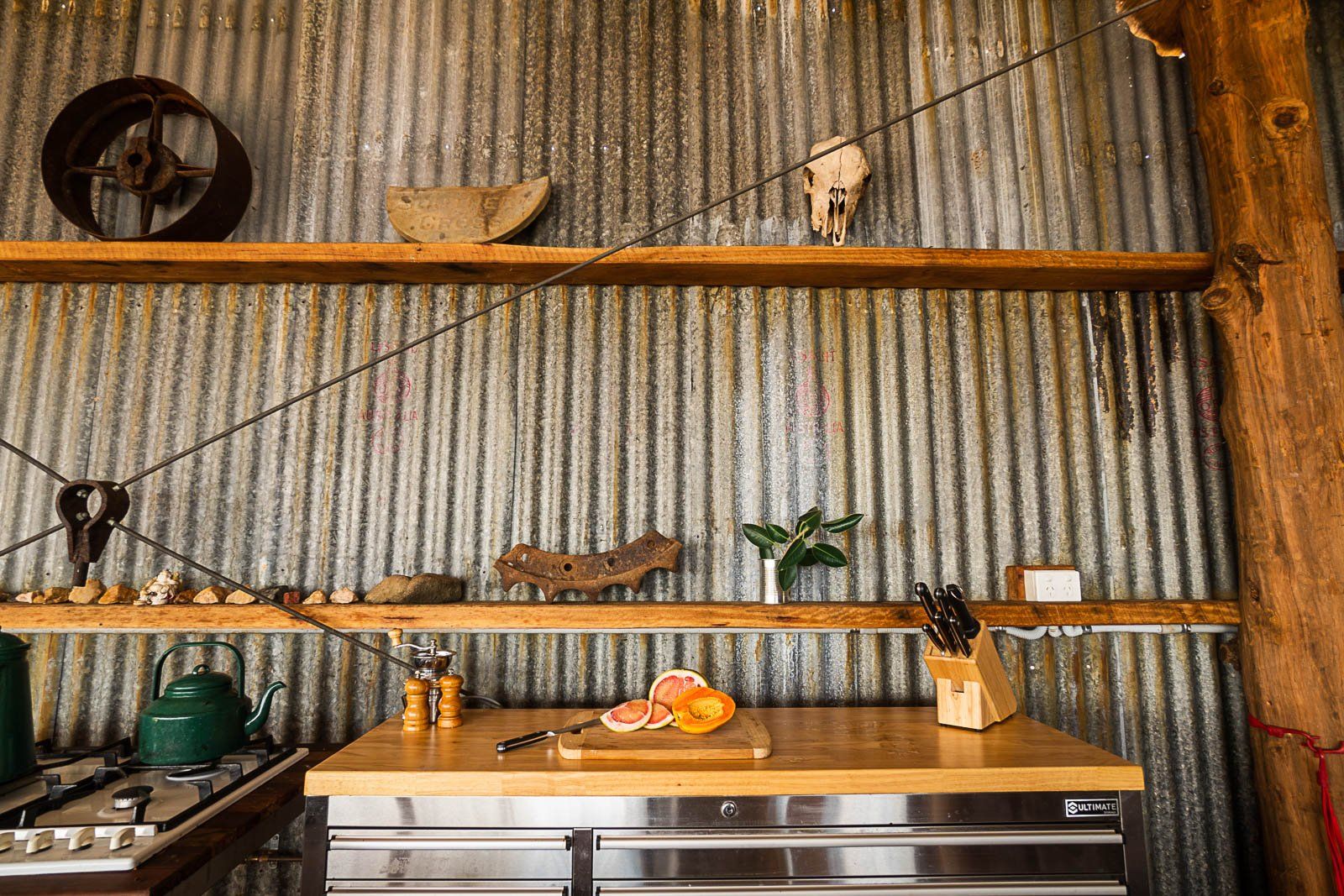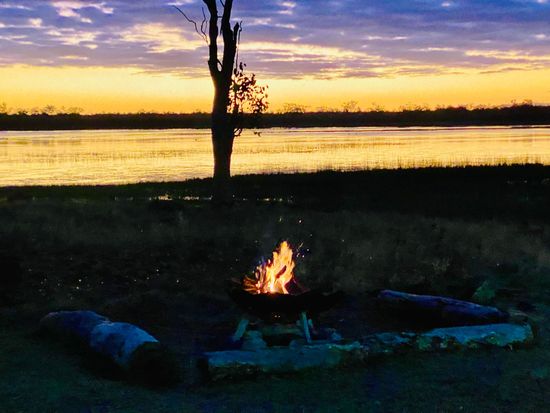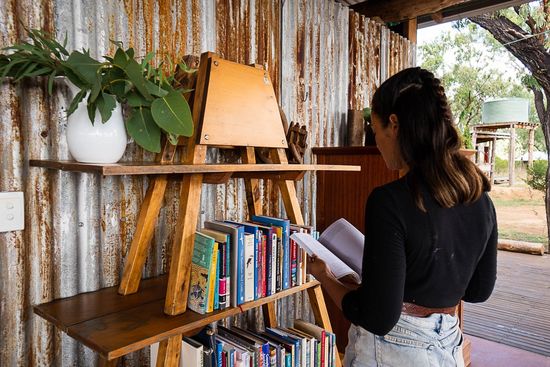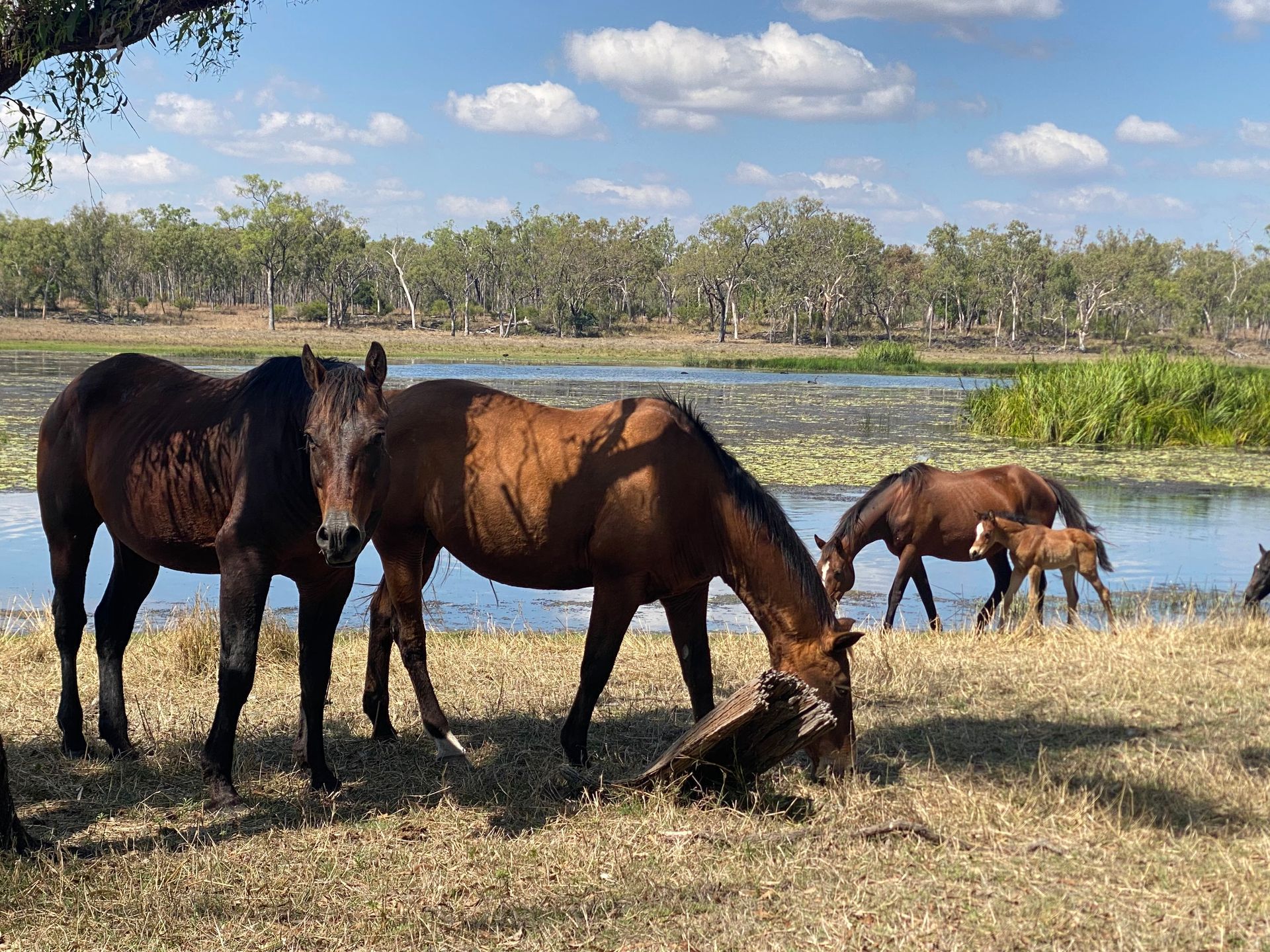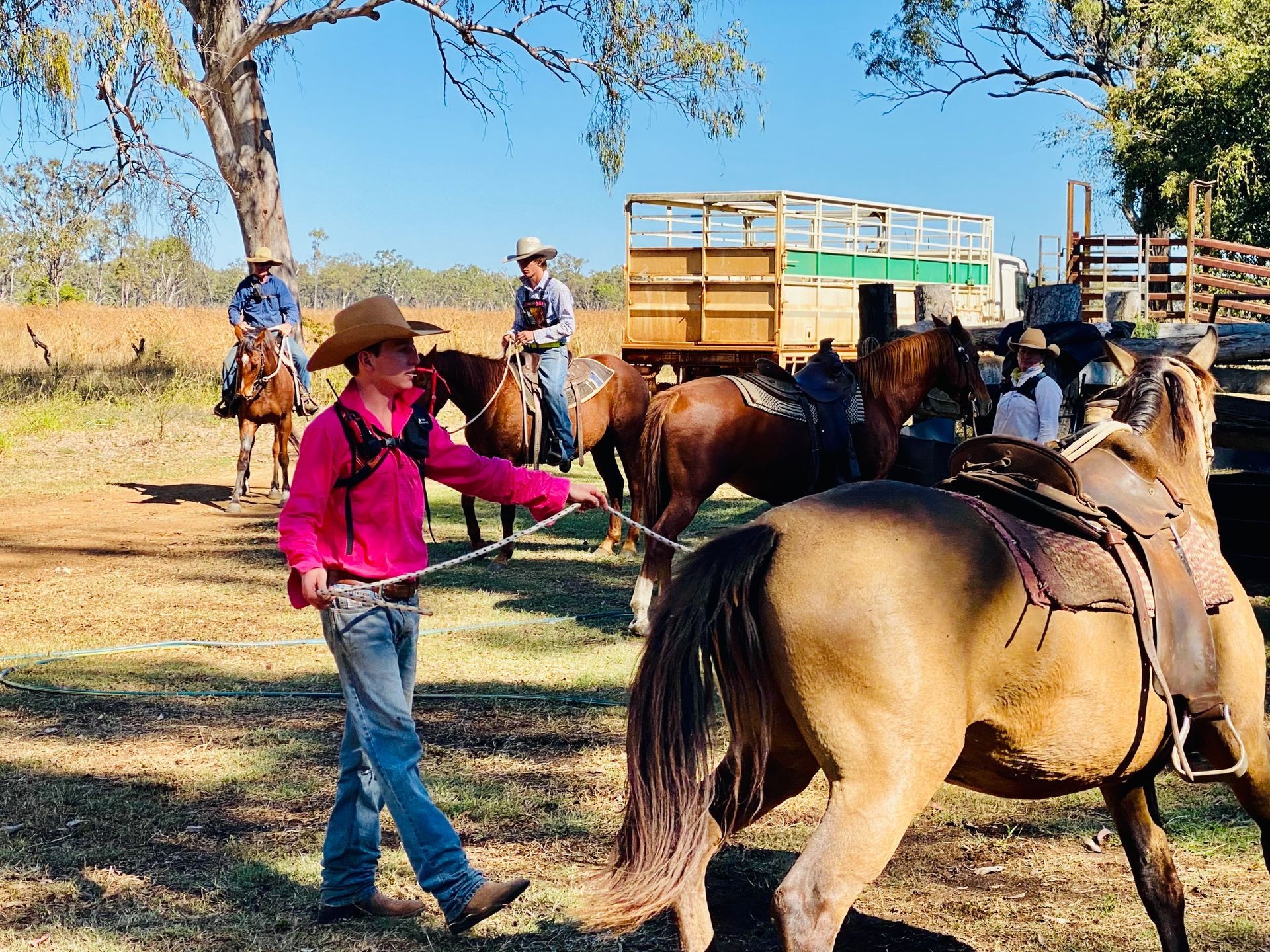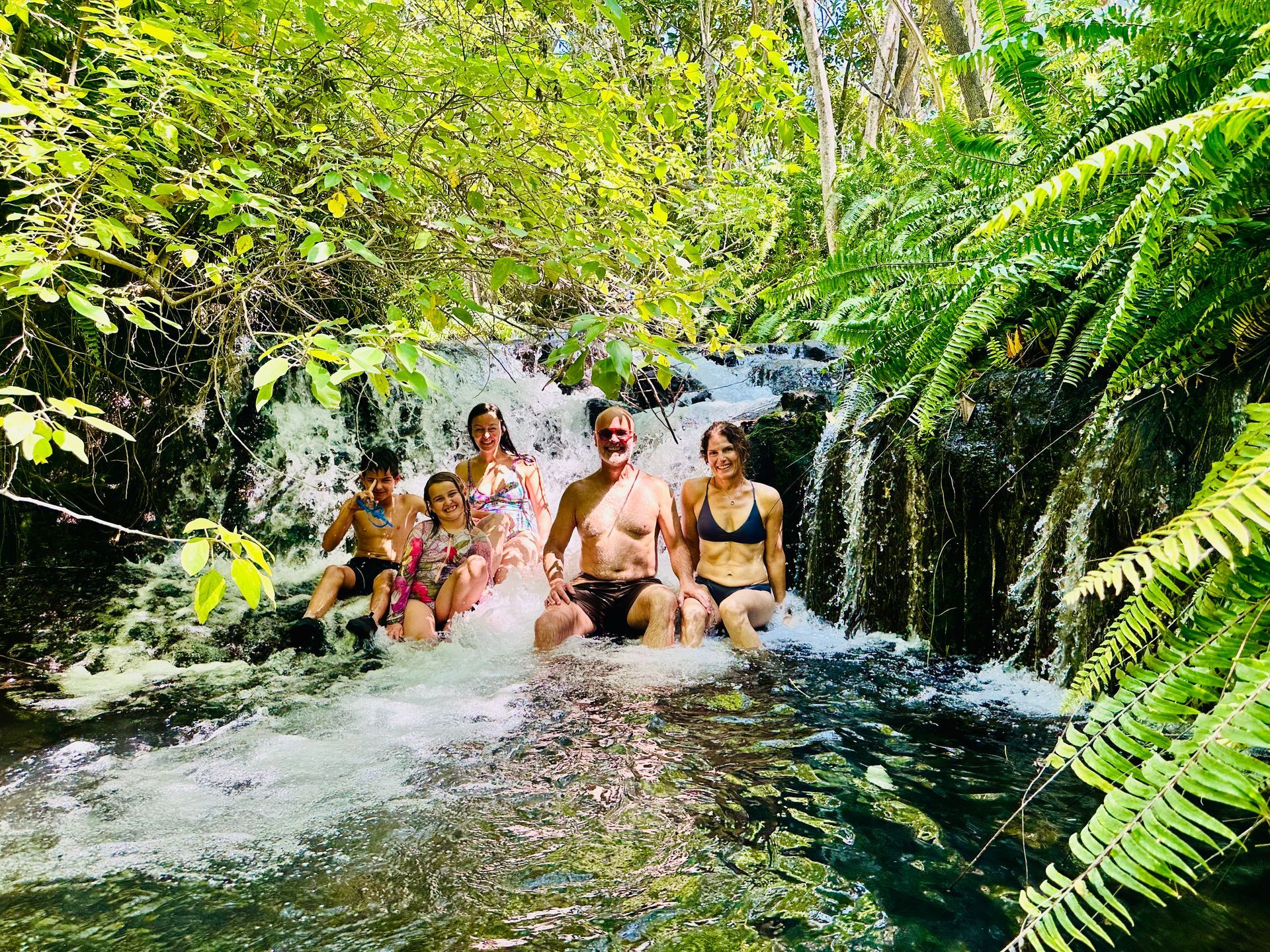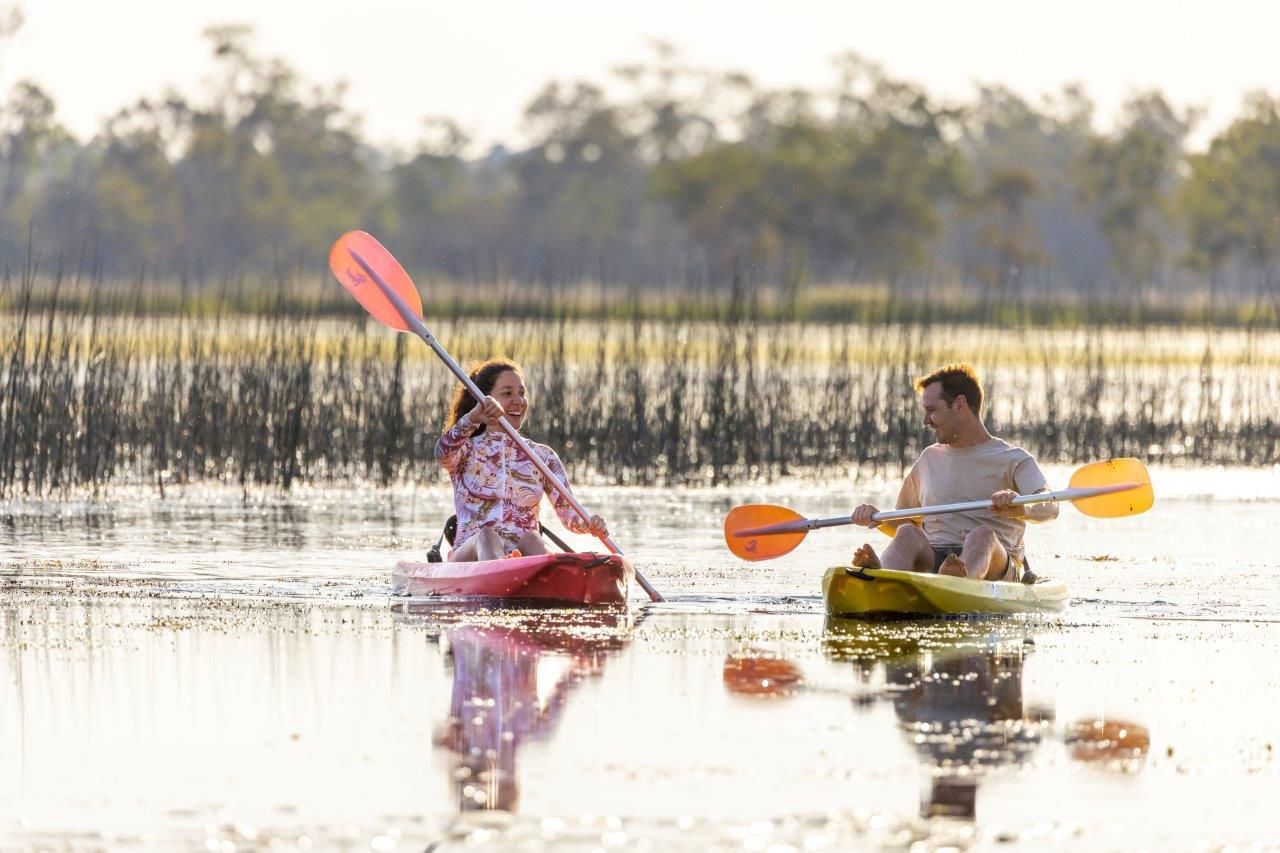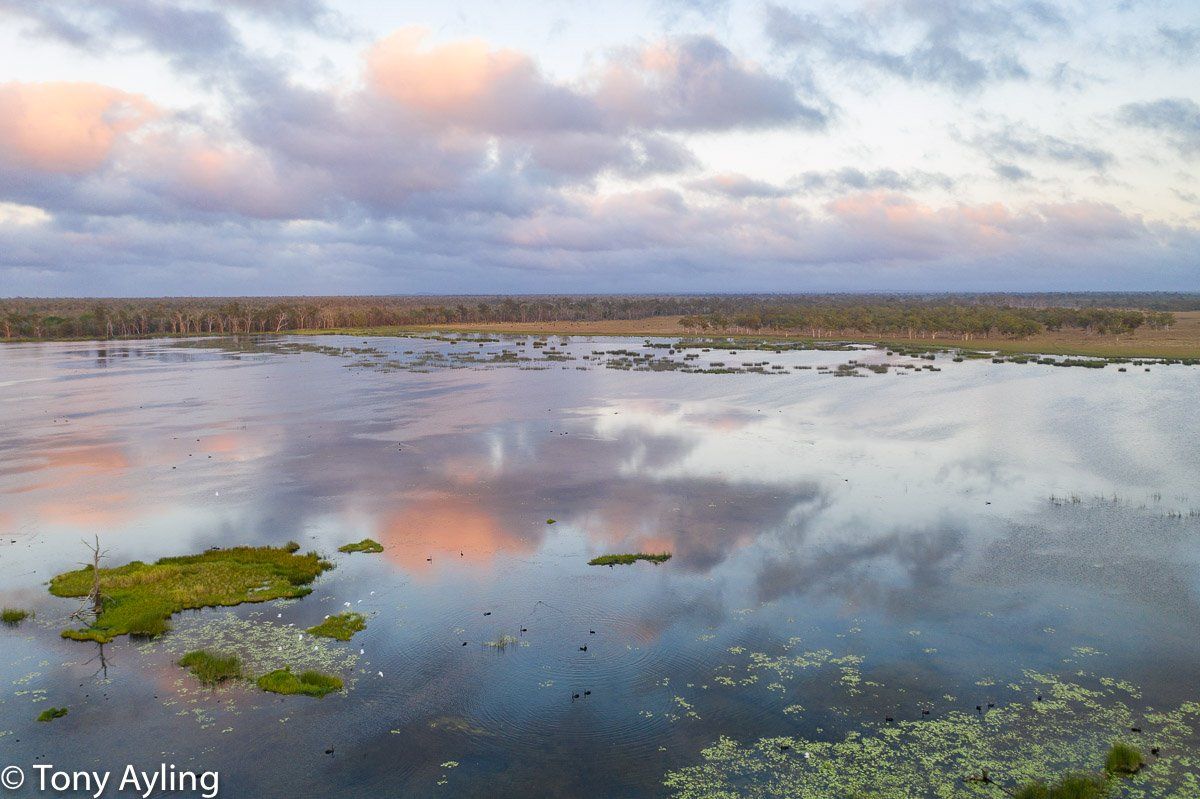Overview of the Kinrara expedition
Hospitality is the luxury at Kinrara
Comfortable private tents with decks
Each tent is set to your desired configuration, ensuring comfort for your stay. Appointed with deckchairs, the balconies offer commanding views of the lake and surrounding wildlife. Inside the tent you'll find your rechargeable lights and head torches, bedding, towels, shelving and space for your possessions.
Hot showers for days
Our communal shower and eco toilet facilities draw marvel from guests at their simplicity yet architectural design. An open fire heats water while gravity from overhead tanks provides water pressure for endless hot showers. Our one true luxury is we don’t have to skimp on water, just relax and enjoy. Our toilets are self-composting waterless and use natural wood shavings and are powered on solar.
Communal dining and lounge
As with most outback cattle stations, we eat family style along one or two large communal tables. With no TV or mobiles to distract us, we find conversation abounds and many stories and much laughter is shared. The central pavilion also offers many spaces to relax and take in the view, read a book, play a board game or finish a puzzle. A beverage is never far away, be it hot brewed coffee or teas, or a tart Gin and Tonic for that perfect accompaniment to the immense sunset.
The Food
Our food philosophy is borne of our matriarch Sheena O’Brien. She always catered for every crowd no matter how big or small. Having 4 sons she hosted many large-scale birthday parties, topping 150 guests. Thinking nothing of cooking for 10-15 hungry workers and family food became central to the happiness of the crew. This ethos has carried on with our style of eating; sat together, family style, fresh local produce simply cooked, best shared with your preferred refreshing beverage and good conversation. Meals are punctuated with large helpings of fresh salads, and deliciously prepared vegetables, generously catering to our vegetarian or vegan guests.
Much of our fresh produce comes from local producers in the Tablelands where locals flock to buy regionally sourced high-quality fresh fruits and vegetables. A heady mix of tropical fruits, such as mangosteins, custard apple, rambutan, durian, exotic mangos, lush sweet papaya, and asian citrus are bulging from the stalls. Herbs from every point of the globe are in reach, and avocados and pineapples by the bucket load. Our meats, poultry, pork and seafood are sourced locally and incorporated into our bespoke seasonal menu.
No guest is left hungry or needing more, all dietary requests considered, just ask.
The Drinks Station
Mornings of endless fresh brewed coffee and a broad assortment of teas. All were purchased locally from Tablelands coffee plantations and local tea growers.
A selection of non-alcoholic beverages is always available at the Drinks Station, from classic soft drinks to bush lemon and mint iced water.
Over lunch and later in the evening, we open the bar. A curated selection of Australian wines designed to match our rolling menu along with a range of refreshing local and boutique beers are the order of the day.
The People
"Share our place, our stories, and the spirit of the bush.”
Join us, and become part of the growing Kinrara community
Kinrara Expeditions is a family-founded and run business set up on the family’s unique cattle grazing property. Shane and Robyn O’Brien have been the owners of Kinrara Station since 2002, with the family settling generations prior next door in 1962 at Craig's Pocket and now operating in partnership with the traditional owners of the land - the Gugu Badhun. The O'Briens agreed to turn the nature reserve within Kinrara into a place to welcome travellers and adventure seekers to explore the land, learn more about the area's unique flora and fauna, and get to know the even more unique inhabitants of Australia's youngest land.
Your Host
Cathy Wharton
Cathy Wharton, the visionary behind
https://nwozsafaris.com.au, is an undisputed legend in the tourism industry, renowned for her passion for the land and an illustrious career as an adventurer, tour guide, and local tour operator.
Cathy has introduced the international market to Kinrara Expeditions. Bringing clients from around the world. Netherlands, USA, Canada, Belgium and France. Who have already experienced the uniquely Australian experience.
Raised on a cattle station in north Queensland with close ties to the aboriginal community, Cathy's deep connection with nature has been a lifelong journey.
In her early 20s, Cathy embarked on extensive travels, exploring the landscapes of Afghanistan, Iraq, Northern Africa, Europe, and sailing across the Pacific Ocean, including the Solomon Islands and Papua New Guinea. These enriching experiences ignited her interest in discovering the treasures of her own country and delving into Aboriginal culture, paving the way for her role as a dedicated tour guide.
With over two decades of experience in the local tourism industry, Cathy and her team of North West Australian Safari guides specialize in delivering unique, high-quality tours to a diverse range of clients, including small groups, VIPs, and private charters, both domestically and internationally.
Cathy's extensive exploration of Australia's varied landscapes, from the Australian Outback and Cape York Peninsula to Arnhem Land, Uluru, the deserts of Western Australia, and the ancient Daintree rainforest, showcases her commitment to showcasing the country's natural beauty. Her passion has not gone unnoticed, as evidenced by her inclusion in the prestigious 'Magnificent Seven (Australian Guides)' by travel expert Mark Chipperfield in World Travellers Magazine in 2016.
Her qualifications, including a Wet Tropics World Heritage Tour Guide Accreditation and a Certificate IV in Tourism Guiding, reflect her dedication to excellence. Cathy has also been honored with the 'Cairns Tourism Association's KAMSLER Award for Promoting Excellence in Tourism.' Additionally, she holds essential certifications such as Senior First Aid and CPR, a Medium Rigid Drivers License, Queensland Drivers Accreditation, and an Australian government-issued Blue Card for working with young people.
Cathy's mission goes beyond guiding tours; she takes pride in fostering an appreciation for Australia's unique beauty, history, and culture. Her goal is to cultivate a genuine understanding and respect for Aboriginal Australians and their ancestral lands. Cathy and her team aspire to leave clients with indelible memories, igniting a lasting desire to explore more of Australia's wonders.
People you'll meet along the way
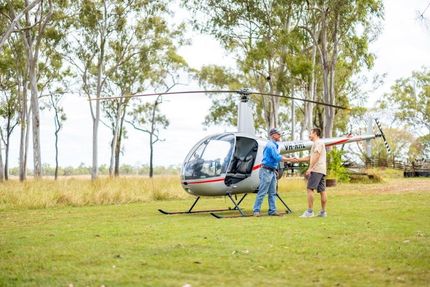
The bush wouldn’t be complete without a few characters along the way. Given Kinrara is an operational cattle and carbon operation a steady stream of visitors come by. Be it Jerry, our helicopter pilot mate, or Shane the bloke who drives our trucks, or one of the neighbours, there’s always a character to meet and a story to be shared.
The Land
Excerpt from the Preface from Gugu Budhun - People of the Valley of Lagoons...
...The Gugu Badhun creation story of Numunali the bronzed-winged pigeon and Bunbunba the pheasant, that has been handed down from one generation to the next in our oral history, marks a 20,000-year-old geological event. The story explains how the lava flow from the Kinrara Volcano created the Gugu Badhun landscape. It is an important creation story which explains how the Gugu Badhun universe was formed. It is our cosmology. The ancient lava flow caused the creation of the mountains, valleys, and permanent spring-fed creeks that are the beginning and the source of the Burdekin River — the life giver to the Gugu Badhun plants and animals. The upper Burdekin — or the black Burdekin — River gave sustenance and life to country and our people for millennia. The same ecology and natural resources that supported and maintained Gugu Badhun people for thousands of years were also attractive to the colonisers. The permanent spring-fed creeks, lagoons and open grassy woodlands of the area were regarded as prime grazing country and, in the late 1800s, the pastoralists moved in......
...Along the watercourses, the vegetation is thick and green, but away from the water it changes dramatically. Here, the countryside is predominantly open eucalypt woodland, dominated by ironbarks and with an understory of grass. While not arid country, it is certainly not lush. Grey kangaroos and agile wallabies are the most obvious mammals, but possums, echidna, bandicoots and many others live here too. Large birds include emu and bustards, while apostle-birds, honeyeaters and parrots provide a noisy background to this archetypal Australian bush setting. In places where the basalt is on the surface, the land may appear barren, but beneath the surface the fissured rock provides the source of the life-giving springs of water that nourish these lands.
The story of Kinrara's land today
Following in the footsteps of his Grandfather and Father, Shane O’Brien is a respected modern day grazier in the North Queensland area. Born just next door to Kinrara, the original location of the family's settlement in the region in the early 1960’s, Craigs Pocket.
The eldest of 4 brothers Shane has worked with the family business his entire life, continuing this tradition Shane, his wife Robyn and sons Angus, Stirling and Corbett now own and run Kinrara Station, a fully operational cattle, eco-tourism and carbon sequestration enterprise. The family manages multiple large herds of cattle spread across the region. Shane and Robyn are stewards of the Kinrara Nature reserve, which hosts MacEachern's Camp, the landmark property for Kinrara Expeditions.
With dramatic open expanse, the ever changing landscape offers an immersive environment, cattle roam free in large paddocks feeding on grasses shaded by ironbark gum trees, Australian native animals are visible everywhere one looks, and everyday life ‘in the real world’ couldn’t be further from your mind.
Kinrara station surrounds Kinrara National Park, a private park with no public access. The vine thicket rainforest (1 of only 2 remaining) and solidified lava flow around the camp site are engulfed in what seems endless artesian water. This source flows out of the ground literally 10’s of meters from the Kinrara station homestead.
The land is almost entirely ‘incongruous’ as Jo Mckay explained in our Qantas Travel Insider Magazine from January of 2019,
...we pull up at a patch of bleached grass on the opposite side of the field. As we pile out of the 4WDs, laughter ripples through the group; it’s a mix of awe and disbelief. Behind us are hectares of grass dotted with livestock and gum trees in a palette of parchment, cinnamon and sage-green, while in front is a miniature rainforest with an emerald canopy of umbrella palms and fig trees. At its centre, a clear spring gushes from an unseen source into a shallow three-tiered waterfall between banks stacked with lush ferns. Cattle. Outback. Rainforest. Waterfalls. The combination seems incongruous and remarkable.
Facts and figures about Kinrara
Where is Kinrara?
250km south west of Cairns, 120km east of Cardwell, Queensland, Australia.
How do you get to Kinrara?
4WD convoy with Kinrara Expeditions, departing on a Monday morning at 9:00am from the Cairns CBD, returning back to Cairns 4:30pm Friday.
How much land does Kinrara cover?
Including the Kinrara National Park approximately 70,000 acres.
Is there an active volcano at Kinrara?
Yes (kind of), the Kinrara volcano is the last volcanic eruption on the continent of Australia. This is estimated to have occurred between 7,000-9,000 years ago leaving behind an intact volcano with crater, and a 30km long solidified lava flow that can still be clearly seen from space. A dormant or extinct volcano is considered to be 10,000 years old or more. Given this, Kinrara represents the youngest landscape in Australia, it’s like stepping back in time to see how Australia was formed.
Was there only one eruption?
No, the science suggests there was upward of 7 major eruptions and lava flow experiences.
How many bird species have been identified at Kinrara?
Our current log suggests that of the possible 220 bird species in the area 195 have been identified at Kinrara, with the vast majority spotted directly out front of the campsite.
How many cattle are on Kinrara?
Depending on the weather and time of year, Kinrara can run between 4,000 and 10,000 cattle.

